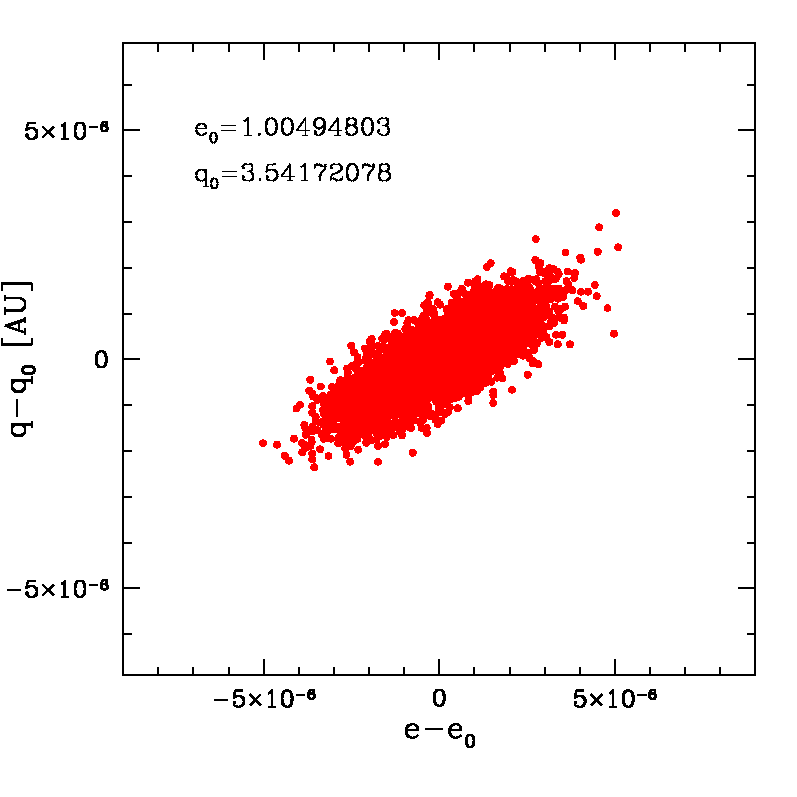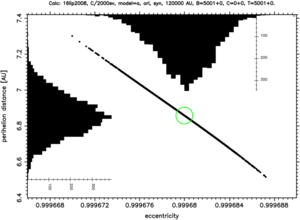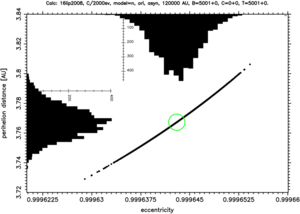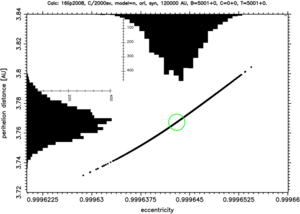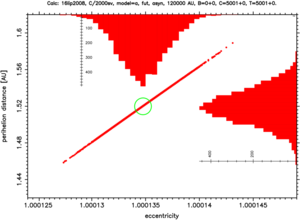Nongravitational nominal solution
Observational arc: 2000 09 05 - 2005 05 12 Number of observations: 2189 RMS: 0.71 arcsec (4349 residuals used, 0.7% rejected residuals )
Heliocentric osculating orbit
Epoch Perihelion time q e ω Ω i
2002 05 06 20020430.474295 3.54159163 1.00479822 76.226350 24.185277 75.237116
± 0.000097 0.00000176 0.00000219 0.000016 0.000005 0.000009
NG parameters:
A1 = (6121.6 ± 80.2 )×10-8 AU/day2
A2 = ( 717.89 ± 60.72)×10-8 AU/day2
A3 = (-513.62 ± 21.70)×10-8 AU/day2
Barycentric nominal Original orbit (at 250 AU from the Sun)
Epoch Perihelion time q e ω Ω i
1698 08 27 20020430.081681 3.52665831 0.99967447 76.496180 24.850674 75.366590
± 0.000341 0.00000232 0.00000301 0.000070 0.000010 0.000012
1/aori = (+92.31 ± 0.85)×10-6 AU-1
Barycentric nominal future orbit (at 250 AU from the Sun)
Epoch Perihelion time q e ω Ω i
2304 04 13 20020429.659239 3.53676676 1.00019411 76.076256 24.885622 75.358207
± 0.000299 0.00000223 0.00000212 0.000063 0.000010 0.000006
1/afut = (-54.88 ± 0.60)×10-6 AU-1
In the 17th edition of the Catalogue of Cometary orbits (2008):
Gravitational orbit (1998 obs.) with 0 < 1/aori < 10-4 AU-1.
The same comet in some other internet sources:
More details
Starting swarms of VCs...(heliocentric, osculating orbits)
Original and future orbit at the 250 AU from the Sun.
Comet number 21 in the Table: Nongravitational Oort spike comets (26 objects)
| Name | GR (1/a)ori [10-8 AU/day2] | GR (1/a)osc [10-8 AU/day2] epoch [TT] | GR 1/afut [10-8 AU/day2] | RMSGR [arcsec] | NG (1/a)ori [10-8 AU/day2] | NG (1/a)osc [10-8 AU/day2] epoch [TT] | NG 1/afut [10-8 AU/day2] | RMSNG [arcsec] | NG parameters A1 A2 A3 [10-8 AU/day2] tau shift [day] | |
| 21 | C/2000 SV74 LINEAR weighting | +50.23 ± 0.40 | -196.65 ± 0.40 2002 05 06 | -1397.07 ± 0.40 | 1.11 | +92.31 ± 0.85 | -1354.82 ± 0.62 2002 05 06 | -54.88 ± 0.60 | 0.71 | 6121 ± 80 717.9 ± 60.7 -513.6 ± 21.7 |
Note: in the following plots black denotes returning clones while red denotes escaping ones.The nominal solution is located at the center of the green circle. Each plot have a header where date of calculation and some other parameters are coded. Also numbers of returning (B=shown+omitted), escaping (C=shown+omitted) and all (T=shown+omitted) Vcs are shown.
Past orbits, at previous perihelion :
Future orbits, at escape border (no returning VCs) :
